The Tombigbee River flows south through Mississippi and Alabama for nearly 525 miles, over 200 of which are manmade, before merging with the Alabama River. It’s one of the principal southern United States commercial routes with locks to enhance navigation. It’s a mighty river for sure and one that humans have used for millennia, but what’s in the Tombigbee River’s murky depths, and is it safe to swim?
Where Is the Tombigbee River?
6,100 square miles of northeastern Mississippi and western Alabama are drained by the Tombigbee River basin. It forms in northeastern Mississippi and flows south to join the Alabama River on the Mobile-Baldwin county line.
It varies in depth, but most of it is navigable due to the lock system that maintains at least nine feet depth for cargo boats. In other areas, it reaches 175 feet deep. This means there’s a variety of habitats for animals.
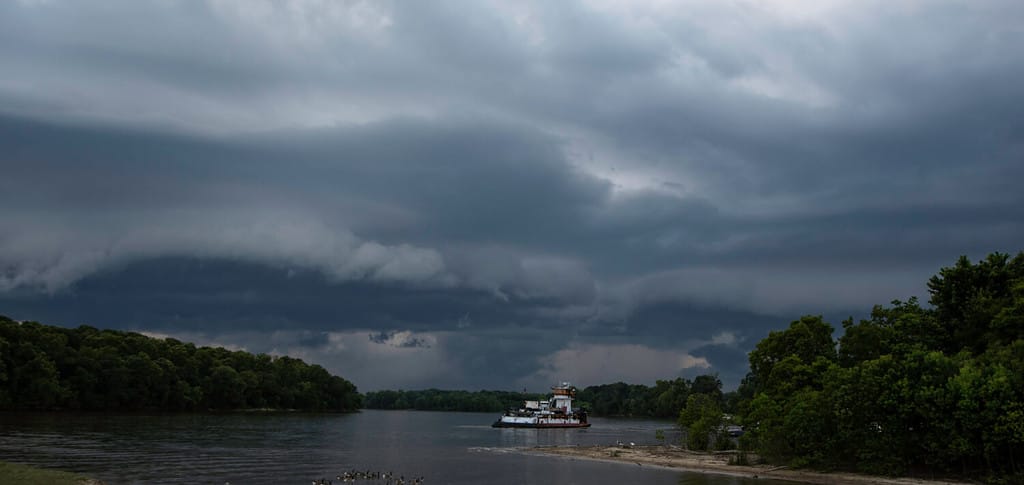
The Tombigbee River provides habitats for numerous animal species.
©JNix/Shutterstock.com
Is There Water Pollution in the Tombigbee River?
Historically, the Tombigbee River was used commercially, leading to pollution issues. For example, in the 1950s, the Ciba-Geigy factory manufactured chemicals, including DDT pesticides, and released hazardous waste into unlined pits that drained into the Tombigbee for over a decade. In 2013, a restorative project was agreed upon, but research shows that its waste is still an issue in certain areas.
Pollution also enters the river from modern-day activities such as erosion and runoff from deforestation, cattle access to streams, crop runoff, and urban settlement pollution.
Experts say that 25% of Tombigbee Basin’s monitored streams are rated very good or good, plus 33% are rated as fair. 42% of its streams are in very poor or poor conditions. If you’d like to read up on the Tombigbee River basin’s water quality, Mississippi’s Department of Environmental Quality has a full citizen’s guide.
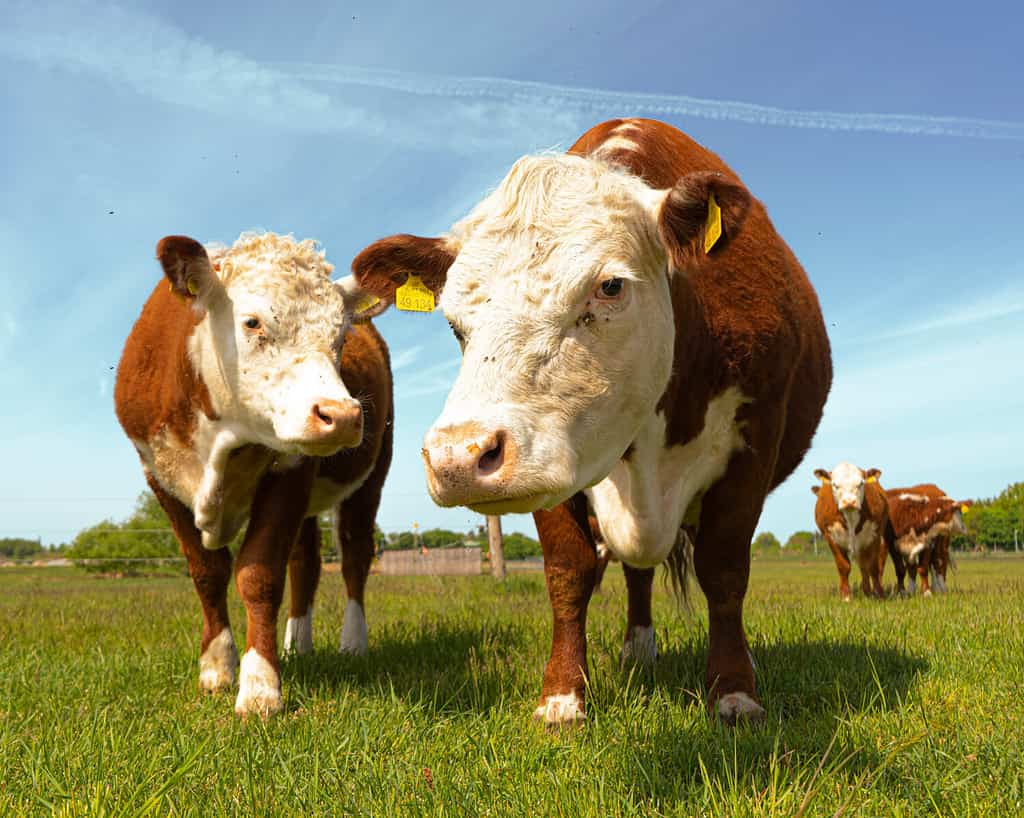
Excessive cattle access to streams and rivers causes pollution downstream.
©247 FILM/Shutterstock.com
What Fish Live in the Tombigbee River?
The Tombigbee River is full of fish. It’s described as an angler’s paradise. The main fish in its murky waters include:
- Channel, blue, and flathead catfish
- Largemouth bass
- Crappie
- Chain pickerel
- Bream
- Bowfin
- Redhorse
Plus, a few rarer species, such as the Tombigbee darter and the protected alligator gar.
If you’re itching to get the hook and line out, be sure to purchase the correct state fishing license for your river area and check notices because areas of the Tombigbee River may have a fish consumption advisory.
For example, in 2021, five miles upstream of the Alabama River confluence (in Washington County), mercury levels meant the Alabama Department of Public Health issued a do-not-eat advisory for largemouth bass.

Anglers hook largemouth bass,
catfish
, and crappie in the Tombigbee River.
©iStock.com/mpwoodib
But hold on because there’s bigger fish to watch out for.
In 2013, a fisherman caught a live bull shark in the lower Tombigbee. It was juvenile, but adult bull sharks reach 14 feet long. Bull sharks tolerate salt and fresh water, and it’s not unknown for them to appear in rivers. They have a reputation as one of the most dangerous to humans.
But that’s not all because several anecdotal reports from 2013 suggest stingrays inhabit the Tombigbee River as far north as Bates Lake!
What Creatures Live in the Tombigbee River?
Alongside fish, what else inhabits the Tombigbee River?
Mussels
Mussels once flourished in the Tombigbee Rover, but pollution and dredging issues threatened their survival. After the conservation efforts began, over 50 mussel species returned to the Tombigbee River basin area. Species include the black clubshell, which is a rare Mississippi native.
Mussels are sensitive to their environment, so their presence is a good indication of water quality.

Mussels help indicate the cleanliness of Tombigbee River waters.
©RLS Photo/Shutterstock.com
Salamanders
Salamanders live on land, but they need moist conditions. Logs, rocks, and crevices near the Tombigbee River provides excellent habitats for this elusive creature.
Carnivorous salamanders eat insects and larvae and stick their eggs to the bottom of rocks and stones.
Aquatic Snails
The Tombigbee River is home to an Alabama endemic aquatic snail called the plicate rock snail. It’s a freshwater species with a gill and notable whorls that reach 0.8 of an inch long. It lives in the shallow gravel of fast-flowing Alabama rivers.
Dams, dredging, and pollution have wiped out 90% of this fascinating creature’s population. Since 1998, it’s been listed as endangered.
Black-knobbed Sawback Turtle
Many turtles inhabit the Tombigbee River, but the black-knobbed sawback is particularly unusual because saw-like black knobs cover its shell.
This endangered turtle prefers large, open rivers with sun-soaked rocks and sandy areas to bask in. They eat worms, snails, insects, crustaceans, and plants, and in turn, alligators and large birds of prey hunt them. Habitat degradation and poaching threaten their existence on the Tombigbee River.
Alligators
And speaking of alligators!
The Tombigbee River is home to alligators. The waters don’t thrash with them, but anglers and visitors spot plenty basking on banks and floating submerged in the brown waters. Resourceful alligators hunt and make homes in ponds, ditches, marshes, and backwaters near the main waterway, too.
Alligators live in most of Mississippi and Alabama. They don’t generally hunt humans, but attacks do happen. The Tombigbee waterways is a favored alligator hunting spot in season.
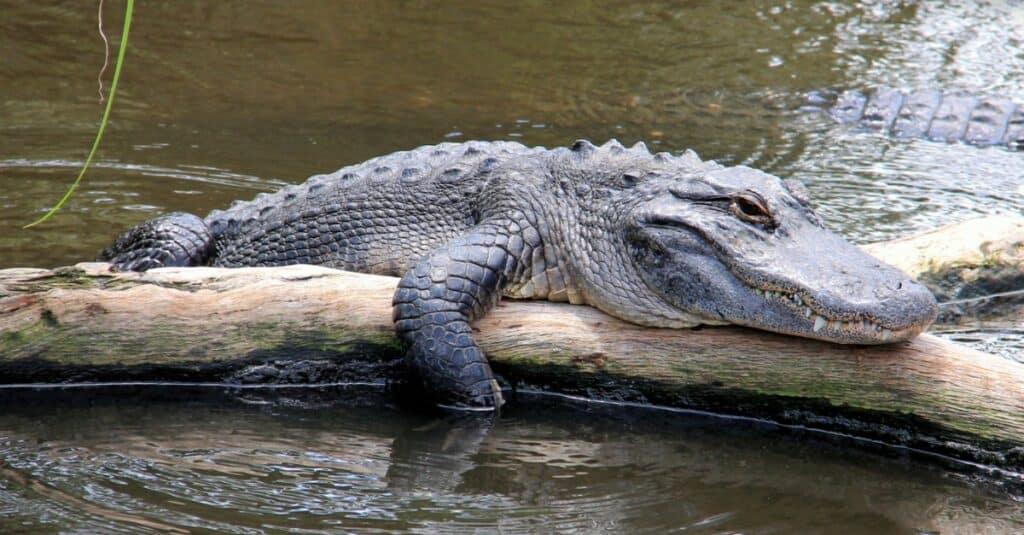
Alligators live in the Tombigbee River, basking on logs and riverbanks to warm up.
©iStock.com/Nikola Art
Snakes
Several snake species inhabit the Tombigbee River, which is bad news if you’re not a fan of the nope-rope.
Diamond-backed water snakes live not only in the Tombigbee River but in ditches, damp fields, ponds, swamps, streams, and lakes nearby. This large non-venomous snake reaches 3-4 feet long and bears a distinctive diamond-shaped pattern along its length.
Other snakes in the Tombigbee River include:
- Mississippi green water snake
- Banded water snake
- Brown water snake
- Mud snake
- Plain-bellied water snake
One to watch out for is the venomous cottonmouth snake, also called the water moccasin. Cottonmouths lie out on logs or rocks to soak up the sun and prey on mice, fish, lizards, and birds there. Although a cottonmouth’s bite needs medical attention, they are not aggressive towards humans and much prefer to slither away to safety.
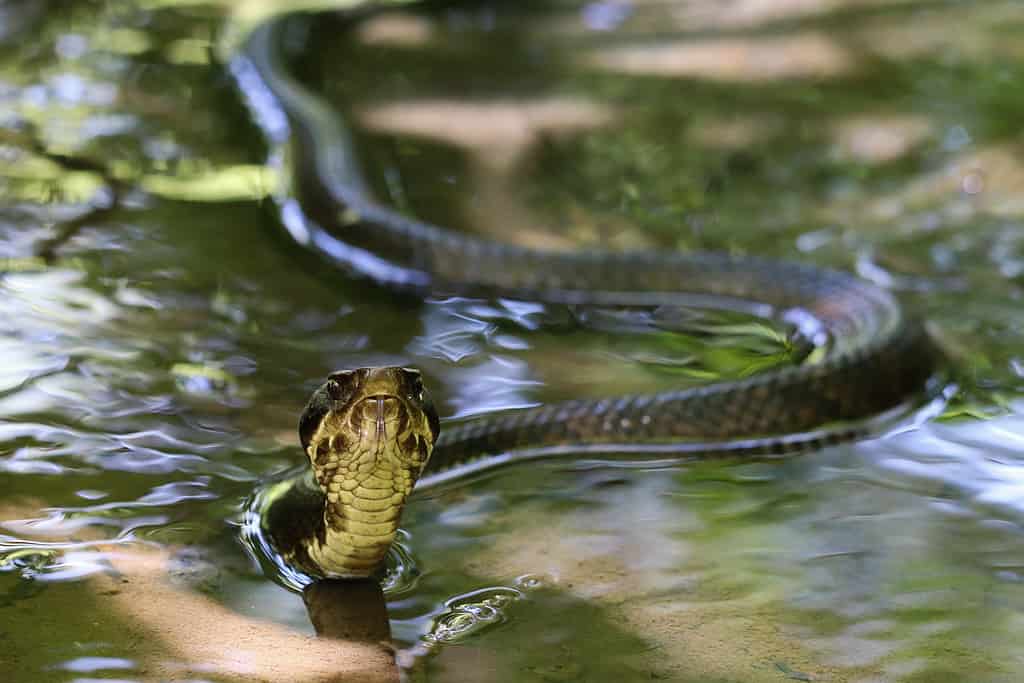
Cottonmouths are also called water moccasins because they hunt in waterways.
©Rafael R Sandoval/Shutterstock.com
Animals Living Near the Tombigbee River
Numerous interesting animals live near the Tombigbee River, all taking advantage of the drinking water there.
Expect to spot muskrats, raccoons, minks, otters, and various bird species,s including the great white egret, deer, wild turkey, and a small black bear population.
Wrecks in the Tombigbee River
For countless years, people have used the Tombigbee River for food, water, and transportation, so it has a fair share of wrecks and subsequent ghost stories.
The Eliza Battle steamboat is one of the best-known. It ran in the 1850s between Mississippi and Mobile, Alabama. A fire occurred onboard in 1851 that killed 33 people, and since then, the Eliza Battle ghost ship has reportedly been seen numerous times, burning on the river.
Another Tombigbee ghost ship spotted on the water is the Jas. T Staples, a paddle steamer, was destroyed by an explosion in 1913 that killed ten people. Rumors at the time suggested a supernatural explosion because it occurred just one week after the former captain committed suicide due to financial issues that lost him his pride and joy. In reality, it was due to human error.
Remnants of shipwrecks lie below the Tombigbee River’s surface, from large paddle steamers to rowing boats. Once enjoyed by people, they now shelter fish.
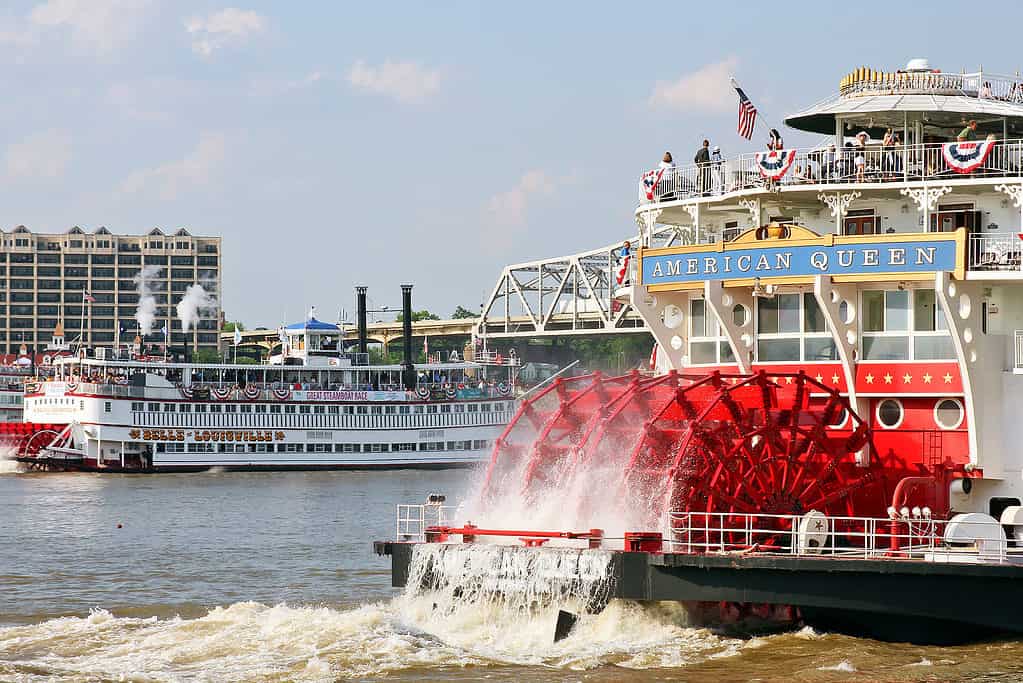
The ill-fated Eliza Battle was a steamboat, much like the American Queen.
©Vicki L. Miller/Shutterstock.com
Is It Safe to Swim in the Tombigbee River?
No laws prohibit swimming in the Tombigbee River, but several hazards mean it’s not safe.
Alligators and venomous cottonmouth snakes live in the waters, and its pollution levels mean it’s not clean enough in all areas. Ingesting polluted waters can lead to stomach upsets and infections that need medical attention.
However, swimming is listed as an activity at the following spots:
- Tombigbee National Forest, located in northeastern Mississippi
- Tombigbee Lake State Park lakes
- Tennessee-Tombigbee Waterway recreation areas
If you’re determined to cool off in the Tombigbee River, it’s safest in allocated areas. However, no one should enter the water if it’s cold, flooded, or if alligators and snakes are spotted.
The photo featured at the top of this post is © JNix/Shutterstock.com
Thank you for reading! Have some feedback for us? Contact the AZ Animals editorial team.






